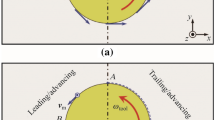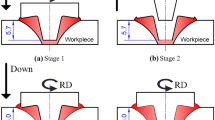Abstract
For better application of numerical simulation in optimization and design of friction stir welding (FSW), this paper presents a new frictional boundary condition at the tool/workpiece interface for computational fluid dynamics (CFD) modeling of FSW. The proposed boundary condition is based on an implementation of the Coulomb friction model. Using the new boundary condition, the CFD simulation yields non-uniform distribution of contact state over the tool/workpiece interface, as validated by the experimental weld macrostructure. It is found that interfacial sticking state is present over large area at the tool-workpiece interface, while significant interfacial sliding occurs at the shoulder periphery, the lower part of pin side, and the periphery of pin bottom. Due to the interfacial sticking, a rotating flow zone is found under the shoulder, in which fast circular motion occurs. The diameter of the rotating flow zone is smaller than the shoulder diameter, which is attributed to the presence of the interfacial sliding at the shoulder periphery. For the simulated welding condition, the heat generation due to friction and plastic deformation makes up 54.4 and 45.6% of the total heat generation rate, respectively. The simulated temperature field is validated by the good agreement to the experimental measurements.











Similar content being viewed by others
References
R.S. Mishra and Z.Y. Ma, Friction Stir Welding and Processing, Mater. Sci. Eng.: R: Rep., 2005, 50(1–2), p 1–78
R. Nandan, T. DebRoy, and H. Bhadeshia, Recent Advances in Friction-Stir Welding-Process, Weldment Structure and Properties, Prog. Mater Sci., 2008, 53(6), p 980–1023
X. Liu, S. Lan, and J. Ni, Analysis of Process Parameters Effects on Friction Stir Welding of Dissimilar Aluminum Alloy to Advanced High Strength Steel, Mater. Des., 2014, 59, p 50–62
K. Sun, Q. Shi, Y. Sun, and G. Chen, Microstructure and Mechanical Property of Nano-SiCp Reinforced High Strength Mg Bulk Composites Produced by Friction Stir Processing, Mater. Sci. Eng. A, 2012, 547, p 32–37
H. Schmidt, J. Hattel, and J. Wert, An Analytical Model for the Heat Generation in Friction Stir Welding, Modell. Simul. Mater. Sci. Eng., 2004, 12(1), p 143
G.-Q. Chen, Q.-Y. Shi, Y.-J. Li, Y.-J. Sun, Q.-L. Dai, J.-Y. Jia, Y.-C. Zhu, and J.-J. Wu, Computational Fluid Dynamics Studies on Heat Generation During Friction Stir Welding of Aluminum Alloy, Comput. Mater. Sci., 2013, 79, p 540–546
H. Su, C.S. Wu, A. Pittner, and M. Rethmeier, Thermal Energy Generation and Distribution in Friction Stir Welding of Aluminum Alloys, Energy, 2014, 77, p 720–731
W. Tang, X. Guo, J. McClure, L. Murr, and A. Nunes, Heat Input and Temperature Distribution in Friction Stir Welding, J. Mater. Process. Manuf. Sci., 1998, 7, p 163–172
T. Seidel and A.P. Reynolds, Visualization of the Material Flow in AA2195 Friction-Stir Welds Using a Marker Insert Technique, Metall. Mater. Trans. A, 2001, 32(11), p 2879–2884
H.N.B. Schmidt, T. Dickerson, and J.H. Hattel, Material Flow in Butt Friction Stir Welds in AA2024-T3, Acta Mater., 2006, 54(4), p 1199–1209
H. Schmidt and J. Hattel, A Local Model for the Thermomechanical Conditions in Friction Stir Welding, Modell. Simul. Mater. Sci. Eng., 2005, 13(1), p 77
Z. Zhang, Comparison of Two Contact Models in the Simulation of Friction Stir Welding Process, J. Mater. Sci., 2008, 43(17), p 5867–5877
M. Grujicic, G. Arakere, C.-F. Yen, and B.A. Cheeseman, Computational Investigation of Hardness Evolution During Friction-Stir Welding of AA5083 and AA2139 Aluminum Alloys, J. Mater. Eng. Perform., 2010, 20(7), p 1097–1108
P.A. Colegrove and H.R. Shercliff, Experimental and Numerical Analysis of Aluminium Alloy 7075-T7351 Friction Stir Welds, Sci. Technol. Weld. Join., 2003, 8(5), p 360–368
P.A. Colegrove and H.R. Shercliff, 3-Dimensional CFD Modelling of Flow Round a Threaded Friction Stir Welding Tool Profile, J. Mater. Process. Technol., 2005, 169(2), p 320–327
R. Nandan, G.G. Roy, T.J. Lienert, and T. Debroy, Three-Dimensional Heat and Material Flow During Friction Stir Welding of Mild Steel, Acta Mater., 2007, 55(3), p 883–895
D.M. Neto and P. Neto, Numerical Modeling of Friction Stir Welding Process: A Literature Review, Int. J. Adv. Manuf. Technol., 2013, 65(1), p 115–126
S. Ji, Q. Shi, L. Zhang, A. Zou, S. Gao, and L. Zan, Numerical Simulation of Material Flow Behavior of Friction Stir Welding Influenced by Rotational Tool Geometry, Comput. Mater. Sci., 2012, 63, p 218–226
Z. Yu, W. Zhang, H. Choo, and Z. Feng, Transient Heat and Material Flow Modeling of Friction Stir Processing of Magnesium Alloy Using Threaded Tool, Metall. Mater. Trans. A, 2012, 43(2), p 724–737
H. Su, C.S. Wu, M. Bachmann, and M. Rethmeier, Numerical Modeling for the Effect of Pin Profiles on Thermal and Material Flow Characteristics in Friction Stir Welding, Mater. Des., 2015, 77, p 114–125
J.W. Qian, J.L. Li, J.T. Xiong, F.S. Zhang, W.Y. Li, and X. Lin, Periodic Variation of Torque and Its Relations to Interfacial Sticking and Slipping During Friction Stir Welding, Sci. Technol. Weld. Join., 2012, 17(4), p 338–341
H. Atharifar, D. Lin, and R. Kovacevic, Numerical and Experimental Investigations on the Loads Carried by the Tool During Friction Stir Welding, J. Mater. Eng. Perform., 2009, 18(4), p 339–350
H. Wang, P.A. Colegrove, and J.F. dos Santos, Numerical Investigation of the Tool Contact Condition During Friction Stir Welding of Aerospace Aluminium Alloy, Comput. Mater. Sci., 2013, 71, p 101–108
B.C. Liechty and B.W. Webb, Modeling the Frictional Boundary Condition in Friction Stir Welding, Int. J. Mach. Tools Manuf, 2008, 48(12–13), p 1474–1485
G. Chen, Q. Shi, Y. Fujiya, and T. Horie, Simulation of Metal Flow During Friction Stir Welding Based on the Model of Interactive Force Between Tool and Material, J. Mater. Eng. Perform., 2014, 23(4), p 1321–1328
N. Mostaghel and T. Davis, Representations of Coulomb Friction for Dynamic Analysis, Earthq. Eng. Struct. Dynam., 1997, 26(5), p 541–548
M. Assidi, L. Fourment, S. Guerdoux, and T. Nelson, Friction Model for Friction Stir Welding Process Simulation: Calibrations from Welding Experiments, Int. J. Mach. Tools Manuf, 2010, 50(2), p 143–155
ANSYS, I., ANSYS ® Fluent,.
M. Yu, W. Li, J. Li, and Y. Chao, Modelling of entire Friction Stir Welding Process by Explicit Finite Element Method, Mater. Sci. Technol., 2012, 28(7), p 812–817
H. Palaniswamy, G. Ngaile, and T. Altan, Finite Element Simulation of Magnesium Alloy Sheet Forming at Elevated Temperatures, J. Mater. Process. Technol., 2004, 146(1), p 52–60
K.C. Mills, Recommended Values of Thermophysical Properties for Selected Commercial Alloys, Chennai, Woodhead, 2002
P.D. Harvey, Engineering Properties of Steel, American Society for Metals Metals Park, Ohio, 1982
D.M. Neto, M.C. Oliveira, J.L. Alves, and L.F. Menezes, Influence of the Plastic Anisotropy Modelling in the Reverse Deep Drawing Process Simulation, Mater. Des., 2014, 60, p 368–379
W. Woo, Z. Feng, X.L. Wang, K. An, B. Clausen, T.A. Sisneros, and J.S. Jeong, In Situ Neutron Diffraction Analysis of Grain Structure During Friction Stir Processing of an Aluminum Alloy, Mater. Lett., 2012, 85, p 29–32
J.G. Kaufman, Properties of Aluminum Alloys: Tensile, Creep, and Fatigue Data at High and Low Temperatures, ASM International, New York, 1999
A. Bastier, M.H. Maitournam, K.D. Van, and F. Roger, Steady State Thermomechanical Modelling of Friction Stir welDing, Sci. Technol. Weld. Join., 2006, 11(3), p 278–288
U. Donatus, G.E. Thompson, X. Zhou, J. Wang, and K. Beamish, Flow Patterns in Friction Stir Welds of AA5083 and AA6082 Alloys, Mater. Des., 2015, 83, p 203–213
Y. Morisada, T. Imaizumi, H. Fujii, M. Matsushita, and R. Ikeda, Three-Dimensional Visualization of Material Flow During Friction Stir Welding of Steel and Aluminum, J. Mater. Eng. Perform., 2014, 23(11), p 4143–4147
Acknowledgment
The research was supported by the National Natural Science Foundation of China (Grant No. 51375259) and the National Science and Technology Major Project of the Ministry of Science and Technology of China (No. 2012ZX04012-011). Besides, Gaoqiang Chen was supported by the China Scholarship Council (File No. 20130620105) for 2-year study at Oak Ridge National Laboratory.
Author information
Authors and Affiliations
Corresponding author
Rights and permissions
About this article
Cite this article
Chen, G., Feng, Z., Zhu, Y. et al. An Alternative Frictional Boundary Condition for Computational Fluid Dynamics Simulation of Friction Stir Welding. J. of Materi Eng and Perform 25, 4016–4023 (2016). https://doi.org/10.1007/s11665-016-2219-9
Received:
Revised:
Published:
Issue Date:
DOI: https://doi.org/10.1007/s11665-016-2219-9




